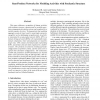CVPR
2012
IEEE
12 years 8 months ago
2012
IEEE
This paper addresses recognition of human activities with stochastic structure, characterized by variable spacetime arrangements of primitive actions, and conducted by a variable ...
CVPR
2011
IEEE
14 years 2 months ago
2011
IEEE
The deformable part-based model (DPM) proposed by Felzenszwalb et al. has demonstrated state-of-the-art results in object localization. The model offers a high degree of learnt in...
NOLISP
2007
Springer
15 years 8 days ago
2007
Springer
We have previously proposed a trajectory model which is based on a mixture density network (MDN) trained with target variables augmented with dynamic features together with an algo...
ICPR
2000
IEEE
15 years 7 months ago
2000
IEEE
A major challenge for face recognition algorithms lies in the variance faces undergo while changing pose. This problem is typically addressed by building view dependent models bas...
CVPR
2004
IEEE
15 years 8 months ago
2004
IEEE
Model-based clustering of motion trajectories can be posed as the problem of learning an underlying mixture density function whose components correspond to motion classes with dif...

